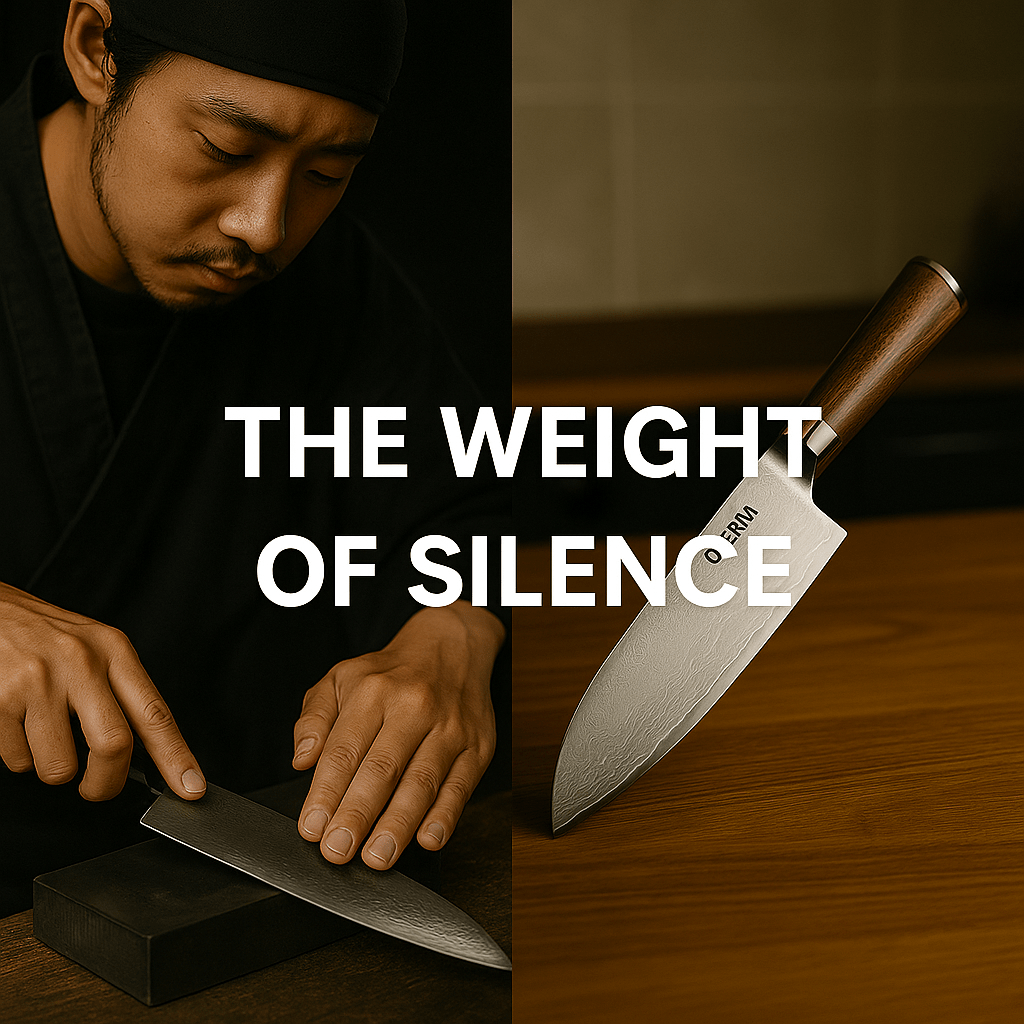
The Weight of Silence – What Makes a True Japanese Knife Different
In every OSERM knife, there lies a quiet strength — a stillness that speaks not through decoration, but through balance, precision, and soul. When you first hold a true Japanese-style knife, you sense it immediately: the weight, the harmony, the purity of form. It’s not just a kitchen tool — it’s a philosophy made tangible. And in that silence, it tells a story of discipline, respect, and legacy.
1. The Essence of the Japanese Blade
In Japanese tradition, the knife is more than an instrument for cutting — it is an extension of the hand, a reflection of the mind. Each curve, balance point, and line has meaning. The smith’s goal is not to overpower the material, but to reveal its inner perfection. This is why, even today, Japanese knives remain unmatched in their combination of sharpness and serenity.
OSERM embraces this heritage. Our VG-10 Damascus knives are forged in the same spirit — 67 layers of folded steel united by heat, hammer, and patience. The rippling patterns on the blade, known as “hada,” symbolize waves in nature: flowing, resilient, and eternal. Every line tells of countless hammer strikes and microscopic precision, the work of human hands guided by intention.
2. The Beauty of Balance
Western knives often emphasize power and mass. Japanese blades, however, celebrate balance and control. The goal is not to dominate the material, but to move with it — to find harmony between the hand, the blade, and the ingredient. This difference in philosophy is what makes a true Japanese knife feel alive — as if it anticipates your movement before you make it.
Each OSERM knife is designed with this balance in mind. The transition from the handle to the blade is seamless, allowing for precision with every motion. The result is effortlessness — a sensation that transforms ordinary cooking into a form of expression.
3. The Craft of Stillness
Forging a knife is an act of silence. There are no shortcuts, no noise — only focus. Every strike of the hammer demands presence. The steel remembers everything: the rhythm, the heat, the patience. When finished, the knife holds that energy within it — invisible, but deeply felt. This is why a true Japanese knife feels different; it’s not just sharpened steel, it’s a vessel of intention.
At OSERM, our artisans understand this. The forging process isn’t rushed; it’s paced to perfection. The edge is hand-finished, the surface polished to reveal the natural patterns of the metal. Every detail whispers rather than shouts, leaving space for the user’s own connection to unfold.
4. The Handle – Where East Meets Hand
While the blade carries strength, the handle carries grace. OSERM’s signature handles are made from natural wood fused with resin, creating a stunning marbled texture unique to each knife. This design isn’t just about aesthetics; it’s about emotion. The smooth, organic form rests comfortably in the palm — warm, balanced, alive.
In Japanese culture, this harmony between hard and soft materials represents the balance of opposites — the yin and yang within craftsmanship. Each OSERM knife embodies this philosophy, merging natural warmth with mechanical precision.
5. The Meaning Behind the Edge
Sharpness, for the Japanese craftsman, is not a measure of aggression but of purity. A blade that can slice through with minimal resistance is a blade in perfect harmony with its purpose. This is why Japanese knives are honed to angles far finer than most Western counterparts — not for show, but to honor the ingredient itself.
When an OSERM knife glides through a tomato or sashimi, it doesn’t crush or tear — it respects the structure, preserving flavor, texture, and artistry. This precision is not merely mechanical; it’s spiritual respect translated into steel.
6. The Soundless Language of Perfection
Hold an OSERM knife, and you’ll feel it — the quiet confidence that comes from something truly crafted. There’s no need for logos shouting luxury, no gimmicks — only the silent dialogue between you and the blade. It teaches patience, control, and appreciation. It turns cutting into meditation, and cooking into ritual.
This is why so many of our customers describe their first OSERM knife not as a purchase, but as a discovery. They don’t just use it — they form a relationship with it. Each use deepens that connection, each meal carries that calm precision forward. This is what makes a true Japanese knife special: it grows with you, silently refining your craft as you refine your life.
Weekly Deal 🔥
Experience the quiet strength of OSERM’s Japanese Damascus Collection. Forged from 67 layers of VG-10 steel, balanced with handcrafted handles, and presented in our iconic orange gift box — it’s not just a knife, it’s an heirloom of philosophy and precision.
You Might Also Like
- The Language of Craft – Why Handmade Knives Speak Beyond Words
- More Than Sharpness – The Emotional Meaning of a Knife Gift
- The Art of Gifting Precision – OSERM’s Philosophy of Craftsmanship
Tags: OSERM Damascus knives, Japanese knives, VG-10 steel, craftsmanship, balance, orange gift box, culinary tradition, knife philosophy, OSERM design






